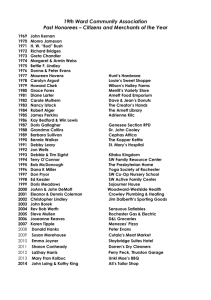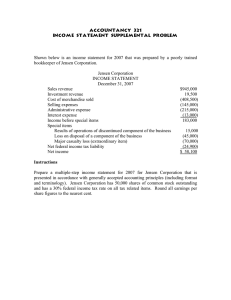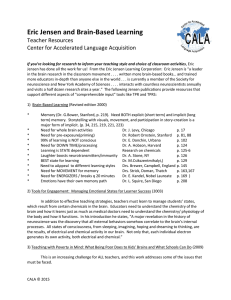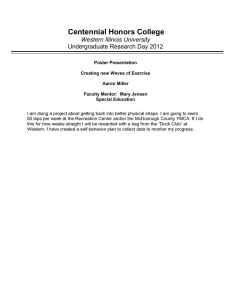5 Human Development A Cultural Approach Toddlerhood
advertisement
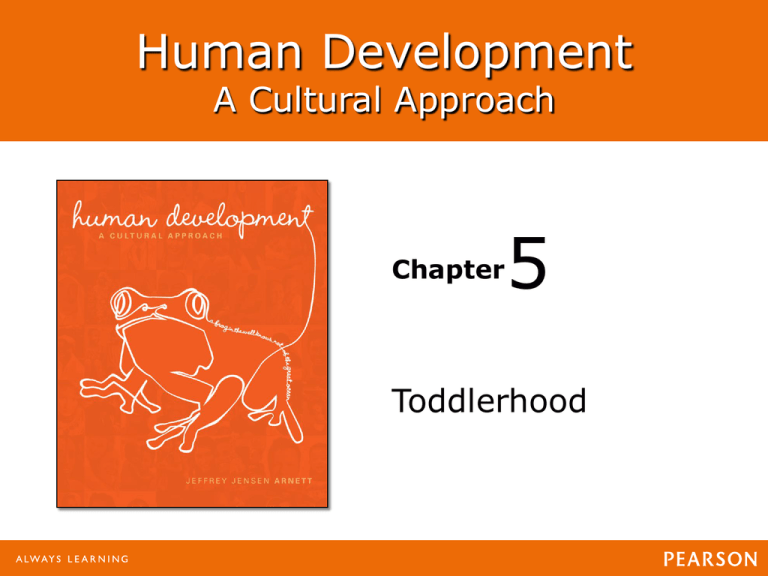
Human Development A Cultural Approach Chapter 5 Toddlerhood Human Development: A Cultural Approach Jeffrey Jensen Arnett Physical Development Human Development: A Cultural Approach Jeffrey Jensen Arnett Bodily Growth • Children lose baby fat and become leaner • About 6 months of age solid food could become part of diet • Deficiencies can occur Kwashiorkor—Protein deficiency Micronutrient deficiency—Lack of crucial vitamins and minerals Human Development: A Cultural Approach Jeffrey Jensen Arnett Figure 5.1 Growth Chart for American Girls From Birth Through Age 3 Growth slows from infancy to toddlerhood but remains rapid. Source: Based on National Center for Health Statistics Human Development: A Cultural Approach Jeffrey Jensen Arnett Brain Development • Early brain development is marked by two key developments Synaptic density—density of synaptic connections among neurons - Frontal cortex heavily impacted Synaptic pruning—connections between neurons become fewer but more efficient - Increases efficiency by allowing unused synapses to wither away Human Development: A Cultural Approach Jeffrey Jensen Arnett Figure 5.2 Changes in Synaptic Density From Birth to Age 2 Synaptic connections increase throughout the first 2 years, with the greatest density occurring at the end of toddlerhood. Source: Conel, 1930/1963 Human Development: A Cultural Approach Jeffrey Jensen Arnett Brain Development • Toddlerhood marks time period during which most methods of measuring brain activity can be used EEG (Electroencephalogram)—measures electrical activity of cerebral cortex FMRI (Functional Magnetic Resonance Imaging)—uses a magnetic field to record changes in blood flow and oxygen Human Development: A Cultural Approach Jeffrey Jensen Arnett Figure 5.3 • fMRI Machine It is not until after toddlerhood that most children can lie still long enough to have an fMRI. Human Development: A Cultural Approach Jeffrey Jensen Arnett Sleep and Teething • Sleep declines from 16–18 hours as newborn to about 12–13 hours by second birthday • Sleeping through the night can be impacted by several things including Resurgence of teething Awareness of separate sleeping arrangements Human Development: A Cultural Approach Jeffrey Jensen Arnett Motor Development: Gross Motor Development 11 months—walk without support 15 months—stand and begin to climb 18 months—some running 24 months—can kick with more dexterity • Developed and developing countries may show some slight age range differences but development progresses comparably • • • • Human Development: A Cultural Approach Jeffrey Jensen Arnett Table 5.1 Milestones of Gross Motor Development in Toddlerhood Source: Based on Adolph & Berger (2006); Rayley (2005); Coovadia & Willenbery (2004); Hrankenburg et al. (1992); Murkoff et al. (2006). Note: The range shown is the age period at which 90% of toddlers achieve the milestone. Human Development: A Cultural Approach Jeffrey Jensen Arnett Motor Development: Fine Motor Development • Fine motor skills are substantial and focus on smaller motor skills • At 12 months can show left or right preference for eating • Also learns to hold cup, scribble with a pencil, and turn pages of a book • Second year expands previous fine motor skills Human Development: A Cultural Approach Jeffrey Jensen Arnett Table 5.2 Milestones of Fine Motor Development in Toddlerhood Source: Based on Adolph & Berger (2006); Rayley (2005); Coovadia & Willenbery (2004); Hrankenburg et al. (1992); Murkoff et al. (2006). Note: The range shown is the age period at which 90% of toddlers achieve the milestone. Human Development: A Cultural Approach Jeffrey Jensen Arnett Socializing Physical Functions: Toilet Training • 4 ways to identify it is time for toilet training Staying dry for hour or two during the day Regular bowel movements Increased anticipation of the event Directly asking to use the toilet or wear underwear Human Development: A Cultural Approach Jeffrey Jensen Arnett Socializing Physical Functions: Weaning • Breastfeeding for 2–3 years has been typical human custom • Transition from infancy to toddlerhood varies from different cultures • The Bali approach can be a mix of gentle and harsh • The Fulani people separate infants from their mothers during weaning Human Development: A Cultural Approach Jeffrey Jensen Arnett Cognitive Development Human Development: A Cultural Approach Jeffrey Jensen Arnett Piagetian Theory • Piaget’s sensorimotor stage continues into toddlerhood Stage 5: Tertiary Circular Reactions— Intentionally try out different behaviors - Little scientists Stage 6: Mental Representations—Think about possibilities and select actions - Symbolic thought Human Development: A Cultural Approach Jeffrey Jensen Arnett Piagetian Theory • During toddlerhood three other Piagetian ideas become more important Object Permanence - A-not-B error Deferred Imitation - Piaget suggested 18 months but could be sooner Categorization Human Development: A Cultural Approach Jeffrey Jensen Arnett Vygotsky’s Sociocultural Theory • Lev Vygotsky viewed cognitive development as both a social and cultural process • Social because children learn through interaction with others • Cultural because what children need to know is determined by the culture they live in Human Development: A Cultural Approach Jeffrey Jensen Arnett Vygotsky’s Sociocultural Theory • Two influential ideas are Zone of Proximal Development and Scaffolding Zone of Proximal Development (ZPD)— range of skills child can perform IF guided but can’t accomplish alone Scaffolding—Degree of assistance provided • Led to extension of theory Guided Participation—Teaching interaction between two people Human Development: A Cultural Approach Jeffrey Jensen Arnett Language Development: Biology and Evolution • Many evolutionary biologists believe language developed for its social functionality • Important distinguishing feature of human language is Infinite Generativity—Combine symbols in infinite ways Human Development: A Cultural Approach Jeffrey Jensen Arnett Washoe, the “Speaking” Chimp Human Development: A Cultural Approach Jeffrey Jensen Arnett Language Development: Biology and Evolution • Biologically humans are built for uniqueness in language Unique vocal apparatus Broca’s and Wernicke’s area Genes • Evolutionary advantage to our predecessors Human Development: A Cultural Approach Jeffrey Jensen Arnett Figure 5.4 • Illustration of the Brain Lobes Showing Location of Broca’s Area and Wernicke’s Area Human Development: A Cultural Approach Jeffrey Jensen Arnett Language Development: Milestones • Begins slowly then begins to rise sharply during toddlerhood • 12–18 months called the slow expansion • First 50 words or so part of toddler routine Human Development: A Cultural Approach Jeffrey Jensen Arnett Slow Expansion Holophrases Overextensions Underextensions Slow Expansion Human Development: A Cultural Approach Jeffrey Jensen Arnett Language Development: Milestones • During naming explosion pace of learning new words doubles • Begin to see the process of fast mapping and use of telegraphic speech Human Development: A Cultural Approach Jeffrey Jensen Arnett Naming Explosion Fast Mapping Telegraphic Speech Naming Explosion Human Development: A Cultural Approach Jeffrey Jensen Arnett Language Development: Milestones • During third year toddler becomes more adept at language • Diminished frequency of overextension and underextension • Show understanding of rules of language • May show overregularization—over applying of grammatical rules Human Development: A Cultural Approach Jeffrey Jensen Arnett Language Development: Parenting • Research on American children and parents focus on how language development is fostered Some research suggests social class differences - High income word comparison Maternal responsiveness - Affirmations and expansions - Correlated positively with early milestones Human Development: A Cultural Approach Jeffrey Jensen Arnett Language Development: Cultural Variations • Some believe parent-child interaction is most important for language development • Cultural differences suggests that social environment is also important • Cultural beliefs dictate the importance of conversation with parents, mixed age groups become more important Human Development: A Cultural Approach Jeffrey Jensen Arnett Emotional and Social Development Human Development: A Cultural Approach Jeffrey Jensen Arnett Self-Development in Toddlerhood • This is the stage of life when a distinct sense of self first develops • Self-awareness reflects an understanding of the distinction between self and the external world Self-recognition—recognizing image of self Self-reflection—think about themselves as they would think about others Human Development: A Cultural Approach Jeffrey Jensen Arnett Gender Identity • Children begin to identify as male or female during toddlerhood Sex—Biological status of being male or female Gender—Cultural categories of male and female • Culture communicates gender expectations to boys and girls Human Development: A Cultural Approach Jeffrey Jensen Arnett Gender Identity • Researchers Sidorowicz & Lunney (1998) Male child—50% men, 80% women chose football Female child—89% men, 73% women used doll Human Development: A Cultural Approach Jeffrey Jensen Arnett Emotional Development • Primary emotions develop in infancy • Toddlerhood is when social emotions develop • They include Guilt Shame Embarrassment Envy Pride Human Development: A Cultural Approach Jeffrey Jensen Arnett Emotional Development • Known as sociomoral emotions • Empathy is an extremely important sociomoral emotion Human Development: A Cultural Approach Jeffrey Jensen Arnett Emotional Regulation • Emotional regulation advances in 4 ways Behavioral development Use of language Social demands (external requirements) Development of sociomoral emotions • Terrible two’s still occur possibly to increased sense of self Human Development: A Cultural Approach Jeffrey Jensen Arnett Attachment • Historically thought to be driven by reduction of a distressing physical state • Three important research findings Rene Spitz—emotional delays developed even with infants physically provided for Harry Harlow—baby monkey spent more time with cloth monkey even if being fed by a wire monkey http://www.youtube.com/watch?v=OrNBE hzjg8I Human Development: A Cultural Approach Jeffrey Jensen Arnett Attachment: John Bowlby • Third research findings based on ethology and Konrad Lorenz • john bowlby attachment theory Human Development: A Cultural Approach Jeffrey Jensen Arnett Attachment: John Bowlby • Bowlby concluded that attachment is an emotional bond that promotes protection and survival Primary attachment figure Attachment has an evolutionary base As the child gets older stranger anxiety will develop - Stranger anxiety - Goal corrected partnership Human Development: A Cultural Approach Jeffrey Jensen Arnett Figure 5.5 The Rise and Fall of Stranger Anxiety in the First 3 Years Across Cultures Stranger anxiety peaks around the end of the first year. Source: Kagan et al., 1978 Human Development: A Cultural Approach Jeffrey Jensen Arnett Varieties of Attachment: The Strange Situation • Mary Ainsworth devised a procedure to evoke attachment behavior • The strange situations devised to assess attachment by going through 8 vignettes • Led to the development of four attachment classifications • http://www.youtube.com/watch?v=QTs ewNrHUHU Human Development: A Cultural Approach Jeffrey Jensen Arnett Variations in Attachment • Secure attachment—Mom is secure base, cry upon separation, return to mom upon return • Insecure avoidant attachment—No interaction with mom, no response upon separation or return Human Development: A Cultural Approach Jeffrey Jensen Arnett Variations in Attachment • Insecure resistant attachment—less likely to return, show distress upon separation, show ambivalence upon return • Disorganized-disorientated—extremely unusual behavior, dazed when mom leaves and fear upon return Human Development: A Cultural Approach Jeffrey Jensen Arnett Attachment Quality and Later Development • Attachment theory suggests quality influenced by Maternal Sensitivity—what a child needs at any given time Maternal Responsiveness—quick to assist or soothe when needed Human Development: A Cultural Approach Jeffrey Jensen Arnett Attachment Quality and Later Development • Bowlby suggested that “internal working model of attachment” can apply to later relationships • Research is mixed but the disorganized attachment does seem to be predictive of later problems Human Development: A Cultural Approach Jeffrey Jensen Arnett Critiques of Attachment Theory • Child effect critique Children are born with different temperaments Influence is bidirectional • Cultural critique Attachments are recognizable across cultures May vary on parenting style May vary on classifying insecurely attached infants Human Development: A Cultural Approach Jeffrey Jensen Arnett Figure 5.7 Cultural Variations in the Strange Situation Across cultures, most toddlers exhibit secure attachment in response to the Strange Situation. In this study toddlers in Japan were more likely to be classified as insecure-resistant and less likely to be classified as insecure-avoidant than toddlers in other countries. Source: Based on van IJzendoorn & Kroonenberg, 1988 Human Development: A Cultural Approach Jeffrey Jensen Arnett The Social World of the Toddler The Role of Fathers • Fathers in traditional cultures Provider and disciplinarian (but can be warm) - Some contrast are the Warlpire which have unique bond with daughter and the Manu who are involved after toddlerhood Human Development: A Cultural Approach Jeffrey Jensen Arnett The Social World of the Toddler The Role of Fathers • Fathers in developed countries Provider and interact less with more play than care - Change to more egalitarian in recent years - Parenting learned, not innate Human Development: A Cultural Approach Jeffrey Jensen Arnett The Social World of the Toddler Siblings: Younger and Older • In traditional cultures older siblings may be responsible for the care of the younger sibling • Older sibling can provide emotional comfort and security if primary not around Human Development: A Cultural Approach Jeffrey Jensen Arnett The Social World of the Toddler Siblings: Younger and Older • Younger siblings can lead to negative consequences including attachment changes, increased aggressiveness • Parents can help but conflict is more common in siblings than any other relationship Human Development: A Cultural Approach Jeffrey Jensen Arnett Sibling Rivalry Human Development: A Cultural Approach Jeffrey Jensen Arnett The Social World of the Toddler Peers and Friends • Peer interaction can be understood by types of play Solitary play—all by themselves Parallel play—same activity but not with each other Simple social play—talking, smiling, sharing Human Development: A Cultural Approach Jeffrey Jensen Arnett The Social World of the Toddler Peers and Friends • Toddlers in day care exhibit social play sooner • Friendships can develop as in later ages: Companionship, mutual affection, and emotional closeness Human Development: A Cultural Approach Jeffrey Jensen Arnett The Social World of the Toddler Autism: A Disruption in Social Development • Features for diagnosis include Lack of interest in social relations Abnormal language development Repetitive behaviors Human Development: A Cultural Approach Jeffrey Jensen Arnett Toddlers with autism have deficits in their social and language development. Here, a boy plays alone at a school for children with autism in Beijing, China. Human Development: A Cultural Approach Jeffrey Jensen Arnett The Social World of the Toddler Autism: A Disruption in Social Development • 1:500 children affected by autism • 4:100 have features (Autistic Spectrum Disorder) • Origins are unclear • Although diagnosed between 18–30, it can be seen in infancy • May never develop language • As adults can live with parents or in sponsored group homes Human Development: A Cultural Approach Jeffrey Jensen Arnett The Social World of the Toddler Media Use in Toddlerhood • 58% of children under 3 watch TV everyday • Toddlers understand images are not real although it is not completely clear • Can encourage pro-social behavior • Displacement effect is a concern • It is suggested that children watch no more than 2 hours of television per day Human Development: A Cultural Approach Jeffrey Jensen Arnett
